Neurofeedback decoded: from training to practice (collaboration with IFEN)
on 04 December 2018
Before starting this article, I would like to come back to the events that took place on this blog in recent weeks. Following my last article "NeurOptimal finally admits not to be Neurofeedback", many NeurOptimal practitioners came to insult me and tried to discredit me in the comments, almost everywhere on my site. You know how important I am to the transparency of information, which is why none of these comments have been deleted. You can go and read them, and see what's going on, and then you're free to make up your mind. Between the person who sells NeurOptimal training and poses as a satisfied customer, the person who copies the testimonies from the NeurOptimal site and refers you to their "Research" section that I debunked in this article, or a French representative who tries to manipulate me and leaves when I ask him for proof.... well, here you have an overview of the wonderful world of NeurOptimal in France.
Personally, I had a pretty bad experience during that period, wondering if I hadn't made a mistake. That is the purpose of manipulating of these people. So I contacted researchers, asked for criticism on international Neurofeedback groups and no doctor or scientist could find any objection to my articles. I have even gained recognition, given the quality of my work. These events explain these two months without an article.
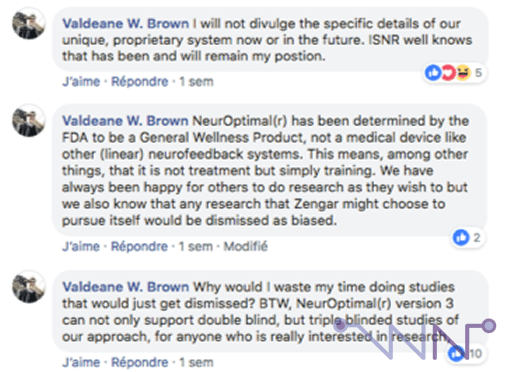
However, this story has brought me three things:
- Bruno Warnotte, who translated into French the AAPB's reference journal "Evidence-Based Practice in Biofeedback & Neurofeedback - 3rd Edition", sent me a copy. I started reading it and already in the first 15 pages, I have ideas for an article. I would promote it in an article and I can even propose to make a group purchase from Canada to split the shipping costs, so if you are interested, get in touch with me, so I can see if it's worth my time there.
- Fred Starr, who initiated the preliminary study on increasing plush cognitive function with NeurOptimal, kindly agreed to be interviewed by me. I still don't know if this will be the subject of an article or if I will subtitle the interview in French, but it will still be only good science and neurofeedback!
- My article was shared in an English-speaking group and I was fortunate to have the co-creator of NeurOptimal who participated in the exchange. This is important to me, because personally, I find that French practitioners are disguising NeurOptimal's original allegations and here is more proof. From the creator's own mouth, NeurOptimal has not been "evaluated" by the FDA but "determined as a wellness device", which perfectly corroborates what I wrote in my previous article and goes against NeurOptimal's French communication. Similarly, the way in which the NeurOptimal operates will remain secret, making scientific research impossible. In any case, in the opinion of the creator of NeurOptimal, any study on NeurOptimal would not be taken seriously by the scientific community, so let's not make it..... This is a recurring point of pseudo-scientific theories: finding an argumentative bias that makes it impossible to build evidence "for" or "against" their theory..... so they don't have to prove that they are right since it is impossible!
Anyway, that's the first aside.
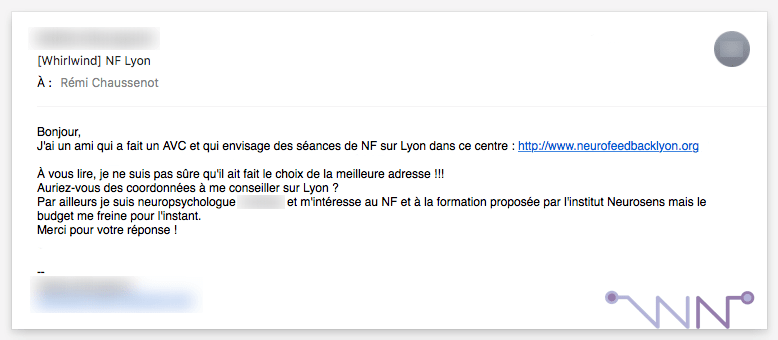
Second, by email, two questions that are often asked:
- How to train for Neurofeedback? I saw the Neurosens Institute, what do you think?
- Where can I find a practitioner who practices Neurofeedback properly?
Generally, I always give the same answer.
On the question of training, I do indeed advise Neurosens, it's simple: they are the only ones to offer BCIA's BCN training in French. So you have no choice.
On practitioners, the answer is not obvious because there is no right answer at the moment. I redirect you to Jean-Loup's website (webmaster of biofeedback.fr and neurofeedback-informations.fr) which lists the people who followed the Neurosens training (which is the theoretical part of the BCN), here by date and here by city. These pages have several gaps:
- following Neurosens training does not mean practicing properly (some continue to practice NeurOptimal);
- Following Neurosens training does not mean practicing (some people do not embark on the adventure because it takes time and commitment to Neurofeedback). They just want to find out and I will come back to that.
So in general, I give the link of the list and I advise to contact Neurosens by their contact form to have more information. I still hope that with the launch of the Francophone Association of Biofeedback and Neurofeedback (AFBN), a different, more accurate and up-to-date list will be put in place. But well, let's say that the AFBN is a little short of volunteers these days, so it takes time...
The advantage of the AFBN (which is a non-profit association under the 1901 law) is that once the first French people are certified BCIA, new training structures can be launched by these people and offer the same thing as Neurosens. As a result, the AFBN will be able to list all this constellation of professionals emerging in the field of neurofeedback, probably more precisely than Jean-Loup, because the selection at the entrance of the AFBN is based on strict clinical and scientific performance criteria.
It is not pleasant for me not to be able to answer your requests, so now that it is noted here, I will add a note on my contact form to this article asking you to stop contacting me for these two topics! :-)
The problem is that advising you Neurosens is cool, but I have never publicly explained why I was advising Neurosens, beyond the "anyway, it's the only ones". Because if they were the only ones and they were bad, I wouldn't advise them. Especially since I have discussed it with many of you: their marketing turns on all the sirens of misinformation for me and does not stick to French standards at all. So if you have to be suspicious of NeurOptimal marketing, using the keys I gave you in my previous articles, you should be suspicious of Neurosens, using the same keys. It's normal, it's not you who get the wrong idea. Except that the training of Neurosens is solid, meets the criteria of the BCIA and that the three people of this institute have, in fact, a very appropriate and scientifically rigorous approach.
So I needed a comparison criterion.
Presentation of T. Feiner and the Neurofeedback-EEG Institute (IFEN) in Munich

Thanks to this blog, I was able to meet Thomas Feiner, director of the Institute for EEG-Neurofeedback in Munich (Germany), which has been in existence for more than ten years. Thomas received his BCIA BCN certification from BCIA in 2011 (it is valid for 4 years and must then be renewed - he is up to date -) and has participated as a speaker at many renowned conferences of ISNR, IOP and others (you know me, in fact, it doesn't interest me).
No, what interests me is that IFEN collaborates with Universities and therefore researchers on various subjects such as: EEGq, Z-Score training or ERP (other forms of neurofeedback). IFEN has also developed Capito (Cognitive Assessment and Performance Ipsative Testing Operations) for clinical and research purposes. IFEN is 4 employees and about 20 instructors supervised by Dr. G. Handwerker for the clinical branch (is he a good doctor? Honestly, I don't care...). IFEN is also international collaboration with clinicians such as Rubén Pérez Elvira (Spain) or Mark Smith (USA). Why is that interesting?
Ruben has two publications listed on Pubmed (and a Google Scholar profile) and Mark Smith also has publications, including the latter, accepted in a journal of the Nature group.
Like Neurosens, the BCIA BCN certification is proposed, but, in my opinion, Thomas goes further with his own certification (IFEN) which seems more demanding than that of the BCIA. However, he wishes to react on this point, and writes:
I wouldn’t write we are beyond the BCIA standards. We are friends with BCIA and many of our trainers are BCIA certified as well. There a great clinicians that don't speak English and we are helping them to receive a certification through our institute, that’s all.
So all this seems very solid to me. That's why I wanted to take Thomas' time and interview him.
I make available, at this address, the original document of our interview. For reasons of transparency, I prefer to distribute it.
Since rather than making a copy/paste here, I'm going to make an effort to write (.... eh), it's also to allow you to check that I'm not misrepresenting Thomas' words.
The objectives of this interview are as follows:
- define neurofeedback (and its controversies);
- go back to products that claim to be Neurofeedback;
- explain the training courses offered to IFEN and the recommended equipment;
- comment on the formation of Neurosens;
- discuss Neurofeedback costs (for both client and practitioner);
- ... and other things.
In other words, to offer you the vision of a professional, who works in collaboration with researchers on the state of Neurofeedback and discuss its democratization in France.
What are the key elements of Neurofeedback?
Before talking about Neurofeedback, we must define this word. If I use it a lot, however, let us not forget that Neurofeedback is only a branch of Biofeedback, the one applied to the brain. And there are different approaches (single-site, multi-site, based on slow potentials, evoked potentials and so on) that fall under the term "Neurofeedback".
Thomas began by pointing out that in the field, research is active and technology is evolving. He also points out that there is no one-size-fits-all solution and that if the approach used is important, the way it is implemented in accordance with science and the client's particular case is just as important.
Neurofeedback is above all a new understanding, a new paradigm, on how to approach pathologies. He highlights the correlation between the symptoms and the electrical activity of the brain, but above all that the alteration of this electrical activity by Neurofeedback will most likely induce behavioral changes. This is what he sees every day in his practice (and what the studies say).
Finally, he discusses the fact that many pathologies are caused by poor brain regulation and that this lack of self-regulation can be remedied by Neurofeedback learning.
However, the first thing to do is to locate the source of this lack of self-regulation and this is where a key element comes in: quantitative EEG. It is a real revolution in the field, but it requires experience and detailed knowledge to use it in the right way.
This is why so many Institutes offer "mentoring / supervision", in order to discuss each EEGq with the practitioner in training and it is advisable to attend regular workshops in order to improve on specific topics.
Having results is not the ultimate goal of the Neurofeedback practitioner: it is to have them with as few sessions as possible.
What is the path to becoming a Neurofeedback practitioner? Is it open to everyone?
Once the practice has been defined, the question arises as to who wants to become a practitioner. At IFEN, as in Neurosens, there is selection at the entrance: only medical professions or scientists are accepted. Because it encompasses both sides of neurofeedback: clinical accompaniment (rather learned in the medical professions) and brain map analysis and protocol implementation (which require reading scientific publications). Both Institutes consider that the practitioner will have to put more effort into one or the other, but that in all cases he starts with knowledge on which to build in his future practice.
On the path, I was pleasantly surprised to see that here too, between IFEN and Neurosens, it is quite similar: 5 days of intensive training to learn the basics of EEG, learning processes, SMR wave training (historically, the first type of Neurofeedback), the basics of neurocognitive evaluation and of course, quantitative EEG (briefly).
Then, we come back to the same similarity: supervision, where the practitioner is guided in the beginning of his activity by a more experienced and certified BCN person. This notion of supervision and assistance is really necessary and useful for the practitioner. This is a cost for the practitioner that is added to the cost of the training, so it should be taken into account before starting.
Then comes the question of equipment, which also represents a cost during start-up. I know that Neurosens, who comes from Canada, works with Thought Technology and Mitsar, while Thomas, on the other hand, uses mainly Brainmaster equipment. The president of Brainmaster (Thomas Collura) is a scientist (list of his publications on Pubmed) who has innovated quite a bit in the field of Neurofeedback (on the other hand, his shares on Facebook, in the Brainmaster EEG group, are as catastrophic as Neurosens, I start to believe that competent people underestimate their audience).
Here, Thomas quotes me their Z-Score training approach which is a type of neurofeedback. Very simply, this makes it possible to modulate the feedback according to the quality of the patient's work, whereas very often with other materials, he only obtains an indicator lie "good" or "bad". This modulation, which provides more information, reduces the number and duration of Neurofeedback sessions required.
We may wonder about the relevance of the different approaches in Neurofeedback, but the key point that is common to all: it is their ability to accurately reproduce the EEG signal. And when discussing it with researchers, this is not always the case, even for FDA-certified devices. In particular, the "Evoke System" equipment was brought to my attention, which showed some defects at this level even though it is FDA certified in the United States.
Neurofeedback: placebo? By EEG or fMRI?
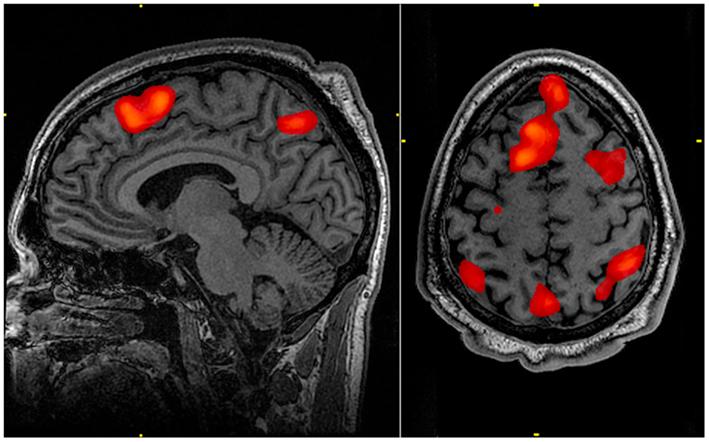
The placebo is a vast subject that regularly animates the scientific community, but also recently the general public. For example, on the subject of homeopathy, which would have no more effect than a placebo (come on, it's been a long time, huh!). Or on Chinese medicine, which would not be more effective than the placebo alone (there, it's just to make new friends). In short, many techniques that make claims of efficacy fail to test whether efficacy is dependent on the placebo effect or their technique. Kind of like Mom's "magic kiss" that has a lot of...... placebo effect.
The most parsimonious approach is to accept that placebo is present in all treatments, so I join Thomas here. This is what Science says (and that's why a drug is defined by its superior efficacy to placebo). But Thomas says that many children who are unaware of the nature of their treatment see their symptoms improve or that people who do not believe in Neurofeedback show positive results. Here, I think we are more in the testimony or at the border. Placebo works in babies or animals. Naivety in the face of treatment is therefore not a good measure of whether or not there is specific efficacy. What proves this specific effectiveness is the double-blind studies and concerning Neurofeedback, we are starting to have some quality ones in recent years (where Thomas participate).
On the slippery topics, I also wanted to discuss Neurofeedback by fMRI. It requires an MRI so is less accessible than EEG, but allows to target deep brain centers more accurately than EEG. I recently learned that my archery trainer was developing real-time analysis algorithms for this type of Neurofeedback, so I'm going to investigate the subject. But enough side note. Briefly, Thomas explains that enough studies have shown the effectiveness of EEG-Neurofeedback..... and well, I agree. This fMRI/EEG opposition is more a battle between researchers who use different approaches (science is fighting to provide evidence, eh) than a debate of interest to the general public.
"Mainstream" neurofeedback
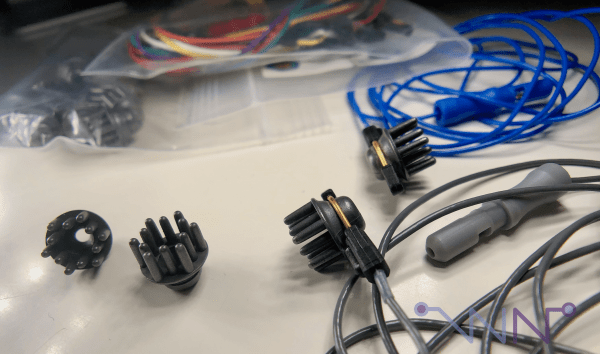
You are many to contact me to have information on "general public" Neurofeedback materials that cost a handful of euros. Honestly, I'm not a pro in this field, Jean-Loup is much more competent than me on the subject (he made this page, very rich in information). On the other hand, I disagree with many practitioners who will say "well, that's crap".
The common feature of these solutions is the use of dry electrodes. If it is dry, it is less effective than wet electrodes placed on a properly cleaned skull. From what I've observed, having bought some to test, actually, the signal is smoother, so we have a loss of information in the high frequencies. On the contrary, I have the impression that the low frequencies are rather well preserved and it is often the credo of these solutions: sleep, meditation, relaxation..... which rest on the slow waves. Thomas says that Muse and Versus show a good EEG signal (according to scientific studies, I rather agree).
Moreover, at IFEN, there are "Neuromeditation" workshops, which are basically neurofeedback-assisted meditation. However, he noted the importance of a previous qEEG. Again, nothing should be done blindly and a brain map and a specific attack plan is essential. But it is a track that he has been developing and thinking about for many years as well, which seems to me to be quite valid.
Well, not surprisingly, he absolutely does not recommend using these materials in the professional context and even less on identified pathologies. It's not medical, is it?
Concerning the medical and the Koala solution from Mensia, by the way. They FINALLY redesigned their site, following my article in April. I'm still waiting for their scientific publication now. So I'll take another look around again. Thomas and I share the same point of view here: yes, it can be effective, but it will never be as good as treatment with a practitioner in an office. Actually, I see a real potential in Koala, so I keep following it, my opinion is more positive than negative about this approach, everything will depend on what they do with it in the future and how they market it.
What to think of Neurosens?
Before concluding, I asked Thomas about Neurosens' practices.
Neurosens is the only BCIA accredited training institute in France, if their website is super well done (seriously, no kidding, it's rare, it's worth mentioning), generally it's either unread or misunderstood. In contrast, their communication sometimes suffers from flaws, like the Internet in general: the sharing of articles that are too simplistic for my taste.
However, having an external opinion, one that has nothing to do with Neurosens, seemed useful to me. So here we are, then.
So, during the training, Neurosens proposes to invest in a ProComp (two channels for two electrodes) and they have developed a solution for Biograph to create a "mini EEGq" by sequentially moving the electrodes to 10 or 19 sites. This is a less expensive solution than the Mitsar which makes real 19-channel qEEG, so they offer this to start at a lower cost. Thomas notes that an evaluation, even a partial one, is in any case better than none. And highlights that this M.O. will give less information than a real EEGq. Which seems obvious. So, the approach is not stupid to start with, but it will never replace a real qEEG assessment (Jean-Loup reminds me that there is no qEEG certification provided by the BCIA, it refers to the qEEG Certification Board).
He also brought to my attention, by e-mail:
As for a mini-qEEG with ProComp 2(1), it should be noted that with the Atlantis(2) (2 or 4 channels) of BrainMaster + an additional device(3), it is possible to use an electrode cap. So, there is no need to move the electrodes, it is the additional module that manages the recording successively on the different sites: Mini-Q II.
- (1) The ProComp 2 costs about 2 500€ (the price is not public on the site, which I have not failed to criticize by email, yes yes);
- (2) Atlantis costs $2,000 (2 channels) or $3,000 (4 channels);
- (3) The Mini-Q II costs $1,500. And the cap $300.
However, Brendan from Neurosens, explains to me that he followed the Brainmaster training (over a week) and was quite disappointed with the software (no idea if he was talking about BrainAvatar, which is the new version), which seemed less ergonomic than the ProComp, hence this choice. Then, Neurosens as a whole, pushes Thought Technology to offer an alternative to Mini-Q, but they still make me notice that the electrode connectors being standard, it must be possible to use any 19 electrode cap and simply change the connections for a sequential evaluation. But their objective being to offer an affordable kit to start with, adding the price of a cap (300-500€ each, so minimum the double, because it is necessary to provide a "child" and an "adult" cap) does not seem to them to be a good calculation. The objective is for the practitioner to go very quickly on a Mitsar (which includes 4 caps). In addition, since Mitsar and Thought Technology have French resellers, it is necessary to take into account the shipping costs, not displayed on the Brainmaster shop (they do however have a reseller in Germany, so to see).
Overall, what I retain from Neurosens and the equipment: it is that they are always on standby for the equipment and alternative solutions. Their choice is therefore not fixed and can evolve, but from their research, currently, what it proposes seems to them to be the best for practitioners. And being the only training group in France, they managed to get big discounts from both manufacturers (without giving the exact number, let's say it's higher than the French VAT, huh).
The single or bi-electrode training that is then recommended by Neurosens is supported by extensive evidence, for example for depression or ADHD, according to Thomas. He also notes here that it is very good to start, but as soon as the practitioner wants to go further, on more complex pathologies, it will not be enough. Jean-Loup believes that ProComp 2 is a little too light for medical or paramedical NFB, because of its sampling rate and resolution (256Hz / 13 bits VS 4096Hz / 24 bits for an Atlantis II), he recommends instead a ProComp 5, 8 or 10 (2048Hz / 14bits) which will be more durable when the practitioner will want to do biofeedback at the same time.
In fact, what is important to understand here is that everyone must start. Thomas started with this kind of system, so did I. It is the practice, experience and time that the practitioner will spend that will push him to go further and invest more in more effective equipment. Before running, you have to learn to walk (it was the naive quote, you needed one). So indeed, in the long term, the practitioner will be interested, for example, in LORETA (Neurosens will also offer training on this topic), which currently offers very good results, more quickly.
I also compared the prices of training courses between the IFEN (the prices are freely accessible on the IFEN website, direct link) and between Neurosens, honestly, they are generally the same.
So I think it is necessary here to be aware of several points:
- the training of Neurosens is of high quality;
- they are strongly involved - and voluntarily - in bringing the BCIA BCN exam to France and in French through the AFBN;
- the 5-day training + the purchase of equipment will not be the only costs: you will need supervision (to get started) and mentoring (required to pass the BCIA BCN certification, but you can do it very well abroad, it will just not be in French);
- following this training, Neurosens offers advanced training that will interest you very quickly.
Neurofeedback cannot be improvised. It is really a rich and exciting discipline, which requires time and money. But I sincerely believe that it is worth it. Really.
However, I strongly advise all health professionals, even those who are not considering Neurofeedback, to consider it: it is a good way to learn about the technique and to be able to talk about it. This may avoid seeing neuropsy pull bullshit like "neurofeedback doesn't hold up over time, so I don't care".
To go further with Neurofeedback
I then asked Thomas about the neurofeedback techniques he uses and are not covered in the initial training. I gave the example of the Z-Score and the evoked potentials (ERP).
For a long time, neurofeedback focused on qEEG, while Thomas explains to me that ERPs are better accepted by neurologists than qEEG. He explains to me that the information obtained is different from that of the qEEG and that the evoked potentials are a good early marker of Alzheimer's disease.
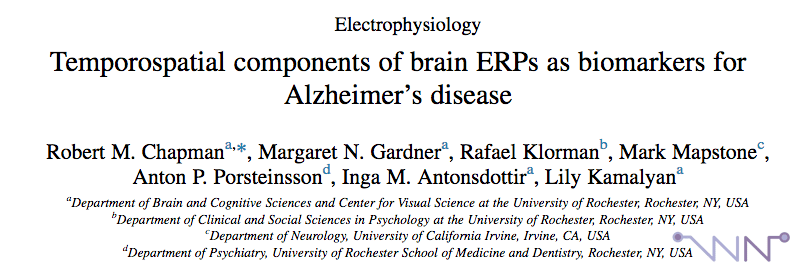
Thomas also uses other techniques in parallel, such as transcranial photobiomodulation or direct current transcranial stimulation. The problem is their duration of action, the results are not maintained over time. It therefore uses in combination with Neurofeedback, whose effects persist due to the learning phenomenon.
Jean-Loup also discusses AVE (Audio-Visual Training), used by many neurofeedback practitioners as a complementary method (before the sessions, for a kind of preparation or conditioning). With the Atlantis from BrainMaster, the AVE is driven by the EEG, unlike AVE systems that operate autonomously with predefined programs.
So for the one who masters Neurofeedback well, there is still a lot to learn from other techniques that also focus on brain function, but with different modes of action and targets.
Neurofeedback, a too expensive technique?
The debate has been going on since, in my opinion, the emergence of Neurofeedback. Neurofeedback is (too) expensive, it is well known and everyone is aware of it.
What we can bring as a practitioner are protocols and materials that reduce the number of sessions while maintaining the same effectiveness. This is where we see potential in Z-Score training or techniques such as infraslow fluctuations (brain waves below 0.1 Hz) that allow better results to be achieved in less time.
So it is a complicated subject, which is known to people who practice Neurofeedback and research is active to reduce this barrier, still too present.
Thomas' advice to French practitioners
There's no reason to be afraid. I don't understand why clinicians refuse to learn more about the brain and help their clients with an approach such as Neurofeedback, which has proven to be much more effective and already helps thousands of clients with no known side effects.
Conclusion
This is the first "real" article to be interviewed with a foreign practitioner. Feel free to give me your feedback, so I know if you like this format.
Others are quite possible, and I have a few names in stock that have already agreed to participate in the exercise. I let you confirm that this is useful and would not be a waste of time.
Thanks a lot to Thomas, don't hesitate to visit his website: http://www.neurofeedback-info.de/en and his Facebook group: www.facebook.com/groups/1758041461107398.
If there are volunteers among you, I think Thomas would not mind finding a French-speaking person willing to bring out IFEN certification from Germany... ;-)
Did you like this article? Then support the blog and share it with your friends by clicking on the buttons* below :
Article url :
http://en.chaussenot.net/neurofeedback-decrypte-formation-pratique-collaboration-ifen
* These sharing buttons are respectful of your privacy and avoid tracking by social networks.



